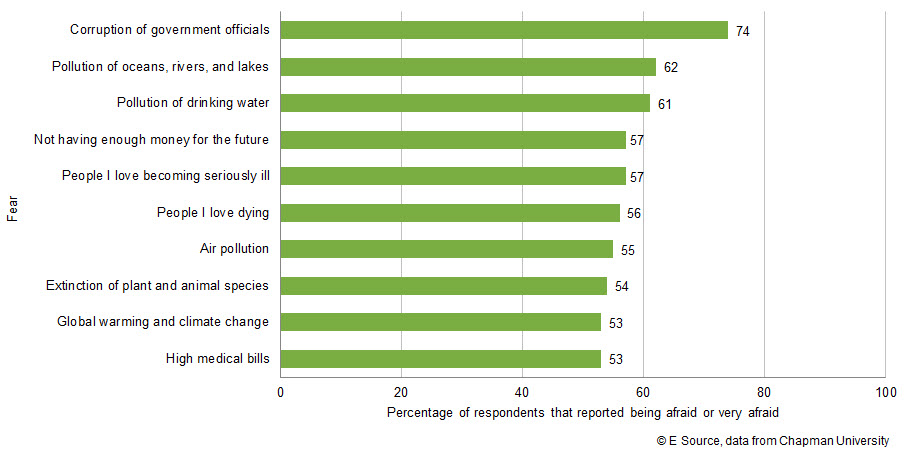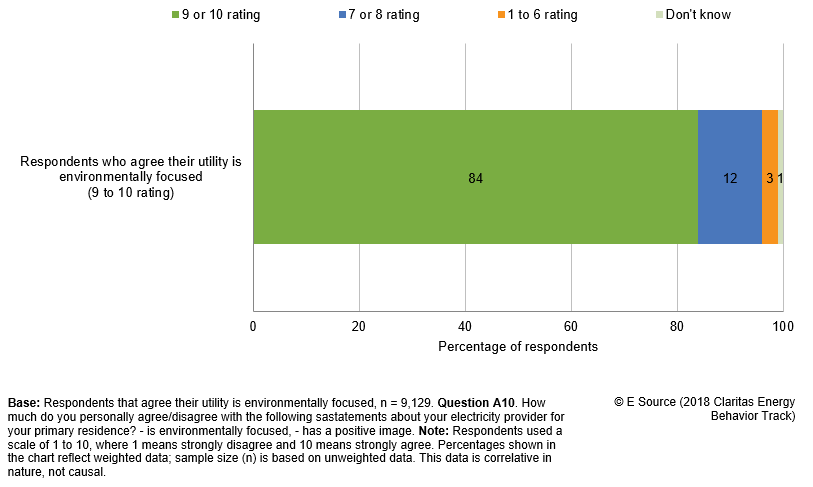
Climate change has been in the news for decades, but today people feel its effects personally. There has been an increase in fear among customers, particularly millennials, regarding the environment’s health. In 2018, five of the top 10 fears in the US had to do with concerns about pollution, global warming, and other environmental disasters according to Chapman University's Survey of American Fears (figure 1). In 2016, none of the top 10 fears related to the environment.
Figure 1: The top 10 fears in the US in 2018
In addition to this fear, people are reporting feeling the effects of climate change on a personal and local level. Yale University's and George Mason University's March 2018 Climate Change in the American Mind study found that 41% of Americans said they have persronally experienced the effects of global warming, which was an increase of 10% since March 2015 (figure 2).
Figure 2: Feeling the effects of global warming
But why should utilities care about climate change? There has been a push for utilities to adopt a more customer-centric business model and care about what their customers care about. Millennials are especially concerned about the environment. In 2018 millennials were twice as likely as baby boomers (75% versus 34%) to say they’re definitely or probably changing their habits to reduce their impact on the environment, according to the Nielsen Company’s Was 2018 the Year of the Influential Sustainable Consumer? 83% of millennials also said it was extremely or very important to them that companies implement programs to improve the environment. Millennials are on track to surpass baby boomers and become the largest living generation in America, according to Pew Research Center’s Millennials Projected to Overtake Baby Boomers as America’s Largest Generation. They are choosing brands that are environmentally conscious and due to the size of their collective voice and buying power, they can’t be ignored. Utilities have the opportunity to engage with this generation and promote its energy efficiency offerings as action that customers can take against climate change.
Data from the E Source Residential Customer Insights Center also shows the potential brand impact that being environmentally conscious can have on utilities. In 2018, of the respondents that strongly agreed their utility was environmentally focused, 84% also strongly agreed that their utility had a positive image (figure 3). Although this is only correlative in nature and not causal, there is potential for an increase in positive brand image by highlighting how your utility is environmentally friendly.
Figure 3: Are utilities viewed as environmentally focused?
Utilities are already addressing the issue of climate change in many ways. The primary method is through offering green pricing programs. There are at least 46 different green pricing programs offered by utilities across the US and Canada. Many of the programs offer 100% renewable options; others offer varying percentages of renewable energy depending on what price the customer is interested in. According to our 2018 Residential DER Customer Market Research, 6% of respondents currently participate in a green electricity program but 14% said they would likely participate in this type of program in the next three years. This market research highlights an opportunity for utilities to promote their green pricing programs to increase participation by highlighting how these options address customer's concerns about climate change and renewables.
Utilities are also addressing climate change through larger commitments. DTE Energy announced in 2017 that it was going to reduce carbon emissions by 80% by 2050, and they’ve recently applied to move the deadline up to 2040. Xcel Energy had one of the most recent and impactful declarations as it serves eight states and committed to zero-carbon electricity by 2050. We acknowledge that these declarations aren’t possible for all utilities, but addressing the issue of climate change and customers concerns in some capacity is an all-around win-win for utilities and customers. Utilities are seen as progressive, customer-focused, and program participation and revenue can potentially increase. Customer’s feel heard by their utility and are able to participate in programs that provide solutions to their environmental concerns. Consider the ways that your utility can address customers concerns about climate change or share with us the ways you’re currently tackling this issue.
Xcel Energy and DTE Energy promoting their renewable energy goals through social media
Members of the E Source Corporate Communications service can learn more by reading the report Utilities’ Role in Addressing Customers’ Concerns About Climate Change, where we dive even deeper into the various ways that utilities are tackling customer concerns about the changing environment and how they’re communicating their efforts to customers.


